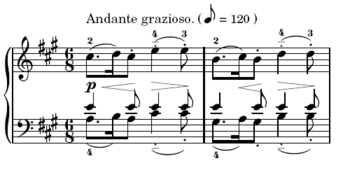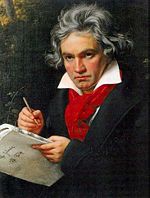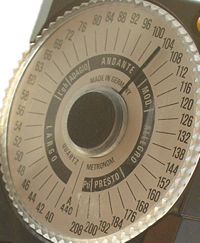Tempo

In musical terminology, tempo (Italian for "time," from Latin Tempus) is the speed or pace of a given piece. It is a crucial element in a musical performance as it affects the phrasing and articulation of a given piece, which in turn affects the resultant mood, expression, or atmosphere.
The plural of tempo in Italian is tempi. Some writers employ this plural when writing in English. Others use the native English plural tempos. Standard dictionaries reflect both usages.
As tempo is identified as the basic pace or movement of the music, it becomes a significant component of the piece. The tempo is created to co-exist in a cooperative relationship with other musical entities. Within a piece of music, no entity is isolated; each works within a mutually fulfilling partnership.
Conductors of orchestras often refer to tactus (time/tempo) and ictus (beat/pulse) when addressing the presentation of a musical composition. French composer Jean-Baptiste Lully (1632-1687) is generally considered the first musician to take on what would become the role of the modern conductor when he would stand apart from an ensemble and beat time (ictus/tactus) with a wooden staff.
Tempo measurement in Europe
Though Johann Nepomuk Mälzel is considered to be the inventor of the metronome, he copied several mechanical ideas of Dietrich Nikolaus Winkel of Amsterdam, who had produced a regulating, time-keeping device in 1812. Mälzel received a patent for his device in 1816. Ludwig van Beethoven was the first important composer to use the metronome to indicate specific tempi in his music. Prior to that time tempo indications had been fairly general and non-specific and were based on Italian terms, such as Allegro, Andante, Adaigo, and so on.
Mathematical tempo markings of this kind became increasingly popular during the first half of the nineteenth century, after the metronome had been invented by Mälzel. However, early metronomes were somewhat inconsistent, and many scholars still consider Beethoven's metronome markings, in particular, to be notoriously unreliable.
As the nineteenth century progressed, composers would indicate the tempo of a given piece by designating "MM" (for Mälzel’s Metronome) at the start of a piece of music. In modern music, this is usually indicated in "beats per minute" (BPM). This means that a particular note value (for example, a quarter note or crotchet) is specified as the beat, and the marking indicates that a certain number of these beats must be played per minute. The greater the tempo, the larger the number of beats that must be played in a minute is and, therefore, the faster a piece must be played. With the advent of modern electronics, BPM became an extremely precise measure. MIDI files and other types of sequencing software use the BPM system to denote tempo.
As an alternative to metronome markings, some twentieth century composers (such as Béla Bartók and John Cage) would give the total execution time of a piece, from which the proper tempo can be roughly derived.
Tempo is as crucial in contemporary music as it is in classical. In electronic dance music, accurate knowledge of a tune's BPM is important to DJs for the purposes of beatmatching.
Description for tempo
Whether a music piece has a mathematical time indication or not, in classical music it is customary to describe the tempo of a piece by one or more words. Most of these words are Italian, a result of the fact that many of the most important composers of the seventeenth century were Italian, and this period was when tempo indications were used extensively for the first time.
Before the invention of the metronome, words were the only way to describe the tempo of a musical composition. Yet, after the metronome's invention, these words continued to be used, often additionally indicating the mood of the piece, thus blurring the traditional distinction between tempo and mood indicators. For example, presto and allegro both indicate a speedy execution (presto being faster), but allegro also connotes joy (from its original meaning in Italian). Presto, on the other hand, indicates speed as such (while possibly connoting virtuosity, a connotation it did not acquire until the late eighteenth century).
Additional Italian words also indicate tempo and mood. For example, the "agitato" in the Allegro agitato of the last movement of George Gershwin's piano concerto in F has both a tempo indication (undoubtedly faster than a usual Allegro) and a mood indication ("agitated").
Indications of tempo
In some cases (quite often up to the end of the Baroque period), conventions governing musical composition were so strong that no tempo had to be indicated. For example, the first movement of Bach's Brandenburg Concerto No. 3 has no tempo or mood indication whatsoever. To provide movement names, publishers of recordings resort to ad hoc measures, such as marking the Brandenburg movement "Allegro," "(Without indication)," and so on.
In the Renaissance period, most music was understood to flow at a tempo defined by the tactus, roughly the rate of the human heartbeat. Which note value corresponded to the tactus was indicated by the mensural time signature.
Often a particular musical form or genre implies its own tempo, thus no further explanation is placed in the score. As a result, musicians expect a minuet to be performed at a fairly stately tempo, slower than a Viennese waltz; a Perpetuum Mobile to be quite fast, and so on. The association of tempo with genre means that genres can be used to imply tempos; thus Ludwig van Beethoven wrote "In tempo d'un Menuetto" over the first movement of his Piano Sonata Op. 54, although that movement is not a minuet. Popular music charts use terms such as "bossa nova," "ballad," and "Latin rock," in much the same way.
It is important to note, when interpreting these terms, that tempos have changed over time, and there can be variances from location to location as well. In addition, the ordering of terms has changed. Thus, a modern Largo is slower than an Adagio, however in the Baroque period it was somewhat faster.
Generally, composers (or music publishers) will name movements of compositions after their tempo (and/or mood) marking. The second movement of Samuel Barber's first String Quartet is an "Adagio." Such movements may start to lead a life of their own, and become known with the tempo/mood marker name. The string orchestra version of the second movement of Barber's first string quartet became known as Adagio for Strings. A similar example is perhaps Gustav Mahler's most famous work—the Adagietto from his Symphony No. 5. Another is Mozart's Alla Turca (here indicating the Janissary music type of mood of the final movement of Mozart's 11th Piano Sonata, K. 331)
At times the link between a musical composition with a "tempo" term and a separate movement of a composition is less clear. For instance, Albinoni's Adagio, is a twentieth century creative "reconstruction" based on an incomplete manuscript.
Some composers chose to include tempo indicators in the name of a separate composition, as is the case with Bartók in Allegro barbaro ("barbaric Allegro"), a single movement composition.
Italian tempo markings
Basic tempo markings
From fastest to slowest, the common tempo markings are:
- Prestissimo—extremely fast (200-208 bpm)
- Vivacissimo—very fast and lively
- Presto—very fast (168-200 bpm)
- Allegrissimo—very fast
- Vivo—lively and fast
- Vivace—lively and fast (~140 bpm)
- Allegro—fast and bright (120-168 bpm)
- Allegro Moderato—moderately cheerful and quick
- Allegretto—moderately fast (but less so than Allegro)
- Moderato—moderately (90-115 bpm)
- Andantino—alternatively faster or slower than Andante.
- Andante—at a walking pace (76-108 bpm)
- Adagietto—rather slow (70-80 bpm)
- Adagio—slow and stately (literally, at ease) (66-76 bpm)
- Grave—slow and solemn
- Larghetto—rather broadly (60-66 bpm)
- Lento—very slow (60-40 bpm)
- Largamente/Largo—"broadly," very slow (40 bpm and below)
- Tempo commodo—at a comfortable speed
- Tempo giusto—at a consistent speed
- L'istesso tempo—at the same speed
- Non troppo—not too much (for example, allegro ma non troppo, fast but not too much)
- Assai—rather, very, enough as is needed (for example, Adagio assai)
- Con—with (for example, andante con moto, at a walking pace with motion)
- Molto—much, very (for example, molto allegro)
- Poco—a little (for example, poco allegro)
- Quasi—as if (for example, piu allegro quasi presto, faster, as if presto)
- tempo di…—the speed of a … (for example, tempo di valse (speed of a waltz), tempo di marzo/marcia (speed of a march))
All of these markings are based on a few root words such as "allegro," = "largo," "adagio," "vivace," "presto," "andante," and "lento." By adding the—issimo ending, the word is amplified, by adding the—ino ending the word is diminished, and by adding the—etto ending the word is endeared. Many tempos also can be translated with the same meaning, and it is up to the player to interpret the speed that best suits the period, composer, and individual work.
Common qualifiers
- assai—very, very much, as in Allegro assai (but also understood by some as "enough")
- con brio—with vigour or spirit
- con moto—with movement
- non troppo—not too much, for example, Allegro non troppo (or Allegro ma non troppo) means "Fast, but not too much"
- non tanto—not so much
- molto—much, very, as in Molto Allegro (very fast and bright) or Adagio Molto
- poco—slightly, little, as in Poco Adagio
- più—more, as in Più Allegro; used as a relative indication when the tempo changes
- meno—less, as in Meno Presto
- poco a poco—little by little
- In addition to the common "Allegretto," composers freely apply Italian diminutive and superlative suffixes to various tempo indications: Andantino, Larghetto, Adagietto, Larghissimo.
Mood markings with a tempo connotation
Some markings that primarily mark a mood (or character) also have a tempo connotation:
- Dolce—Sweetly
- Maestoso—majestic or stately (which generally indicates a solemn, slow movement)
- Morendo—Dying
- Sostenuto—Sustained, sometimes with a slackening of tempo
- Vivace—lively and fast over 140 bpm (which generally indicates a rather fast movement)
Terms for change in tempo
Composers may use expressive marks to adjust the tempo:
- Accelerando—speeding up (abbreviation: accel)
- Allargando—growing broader; decreasing tempo, usually near the end of a piece
- Meno Mosso—less movement or slower
- Mosso—movement, more lively, or quicker, much like "Più Mosso," but not as extreme
- Più Mosso—more movement or faster
- Rallentando—slowing down, especially near the end of a section (abbreviation: Rall)
- Ritardando—delaying (abbreviation: Rit or more specifically, ritard)
- Ritenuto—slightly slower; temporarily holding back. (Note that the abbreviation for ritardando can also be rit. Thus a more specific abbreviation is riten.)
- Rubato—free adjustment of tempo for expressive purposes
- Stretto—rushing ahead; temporarily speeding up
- Stringendo—pressing on faster
While the base tempo indication (such as "Allegro") appears in large type above the staff, these adjustments typically appear below the staff or (in the case of keyboard instrument) in the middle of the grand staff.
They generally designate a gradual change in tempo; for immediate tempo shifts, composers normally just provide the designation for the new tempo. (Note, however, that when Più Mosso or Meno Mosso appears in large type above the staff, it functions as a new tempo, and thus implies an immediate change.) Several terms control how large and how gradual this change is:
- Poco a poco—bit by bit, gradually
- Subito—suddenly
- Poco—a small gradation
- Molto—a large gradation
After a tempo change, a composer may return to a previous tempo in two different ways:
- A tempo—returns to the base tempo after an adjustment (for example, "ritardando … a tempo" undoes the effect of the ritardando).
- Tempo Primo or Tempo I—denotes an immediate return to the piece's original base tempo after a section in a different tempo (for example, "Allegro … Lento … Tempo I" indicates a return to the Allegro). This indication often functions as a structural marker in pieces in binary form.
These terms also indicate an immediate, not a gradual, tempo change. Although they are Italian, composers typically use them even if they have written their initial tempo marking in some other language.
Tempo markings in other languages
Although Italian has been the prevalent language for tempo markings throughout most of classical music history, many composers have written tempo indications in their own language.
French tempo markings
Several French composers have written markings in French, among them baroque composers François Couperin and Jean-Philippe Rameau as well as impressionist composers Claude Debussy and Maurice Ravel. Common tempo markings in French are:
- Grave—slowly and solemnly
- Lent—slowly
- Modéré—at a moderate tempo
- Vif—lively
- Vite—fast
- Très—very, as in Très vif (very lively)
- Moins—less, as in Moins vite (less fast)
German tempo markings
Many composers have used German tempo markings. Typical German tempo markings are:
- Langsam—slowly
- Mäßig—moderately
- Lebhaft—lively (mood)
- Rasch—quickly
- Schnell—fast
One of the first German composers to use tempo markings in his native language was Ludwig van Beethoven. The one using the most elaborate combined tempo and mood markings was probably Gustav Mahler. For example, the second movement of his Symphony No. 9 is marked Im tempo eines gemächlichen Ländlers, etwas täppisch und sehr derb, indicating a slowish folk dance-like movement, with some awkwardness and vulgarity in the execution. Mahler would also sometimes combine German tempo markings with traditional Italian markings, as in the first movement of his sixth symphony, marked Allegro energico, ma non troppo. Heftig, aber markig.
Tempo markings in English
English indications, for example quickly, have also been used, by Benjamin Britten, amongst many others. In jazz and popular music charts, terms like "fast," "laid back," "steady rock," "medium," "medium-up," "ballad," and similar style indications may appear.
Rushing and dragging
When performers unintentionally speed up, they are said to rush. The similar term for unintentionally slowing down is drag. Unless practiced by an experienced performer who "knows what he or she is doing," these actions are undesirable; dragging can often indicate a hesitance in the performer due to lack of practice; rushing can likewise destroy the pulse of the music. Because of their negative connotation, neither rush nor drag (nor their equivalents in other languages) are often used as tempo indications in scores, Mahler being a notable exception: As part of a tempo indication he used schleppend ("dragging") in the first movement of his Symphony No. 1, for example.
The impact of tempo
As the basic speed or pace of a piece of music, the tempo can be any variation between fast and slow speeds which in turn can affect the expressive aspect of the music. A fast tempo may mean great energy and excitement; a slow tempo may create feelings of calmness and solemnity. The impact of the tempo on musical compositions clearly affects the mood of the piece. Tempo indications were a way for the composer to clearly qualify the speed and affect emotion of their compositions.
ReferencesISBN links support NWE through referral fees
- Epstein, David, Shaping Time: Music, the Brain, and Performance. New York, NY: Schirmer Books, 1995. ISBN 0028733207.
- Marty, Jean-Pierre. The Tempo Indications of Mozart. New Haven, CT: Yale University Press, 1988. ISBN 0300038526.
- Randal, Don Michael. The Harvard Dictionary of Music. Cambridge, MA: Harvard University Press, 2003. ISBN 0674011635.
- Sachs, Curt. Rhythm and Tempo: A Study in Music History. New York, NY: Norton, 1953.
External links
All links retrieved February 26, 2023.
- An accurate algorithm to measure the tempo using a digital computer werner.yellowcouch.org
- Dolmetsch article on tempo www.dolmetsch.com
Credits
New World Encyclopedia writers and editors rewrote and completed the Wikipedia article in accordance with New World Encyclopedia standards. This article abides by terms of the Creative Commons CC-by-sa 3.0 License (CC-by-sa), which may be used and disseminated with proper attribution. Credit is due under the terms of this license that can reference both the New World Encyclopedia contributors and the selfless volunteer contributors of the Wikimedia Foundation. To cite this article click here for a list of acceptable citing formats.The history of earlier contributions by wikipedians is accessible to researchers here:
The history of this article since it was imported to New World Encyclopedia:
Note: Some restrictions may apply to use of individual images which are separately licensed.


